We now live in an era where information is accessible through our fingertips and search engines are used as portable libraries. With the past decade having seen vast technological improvements in collecting, managing, understanding, presenting, sharing and using knowledge gained from data and information all over the world, access to the latest updates have become just a web search away. Semantic technologies use a wide range of tools in a similar way the human brain does. It helps process data and information and links them together to create understanding and meaning — keeping track of analysis outcomes, in the form of a conceptual and cognitive map.
According to a new IAEA Report, semantic technology, which underpins web searches and the management of online information, can be used in the nuclear field to help experts and stakeholders maintain, preserve, link and share nuclear knowledge. “Making more use of semantic technology could address the challenge of co-ordinating and compiling information from various institutions by enhancing access to knowledge resources throughout the field on a larger scale,” said Maxim Gladyshev, an IAEA Nuclear Engineer who is responsible for the report.
Semantic technology, especially when combined with artificial intelligence, machine learning, modern taxonomies and ontologies, represents a powerful tool for managing the vast amount of nuclear data, information and knowledge.
One of the many key benefits of using semantic technology is that it improves the organisation of data and information – by linking various sources so they can be shared and reused across sectors, organisations and scientific communities. Through this improved knowledge, information and data organisation, nuclear safety standards, recommendations, experiences, best practices and previous research can become more widely available.
In research, this could have major implications: If already existing data and information can be connected to other sources using semantic technology, research and development in the field becomes easier and faster and could lead to more breakthroughs.
The IAEA is now exploring various prototypes and initiatives with potential benefits to the nuclear industry.







